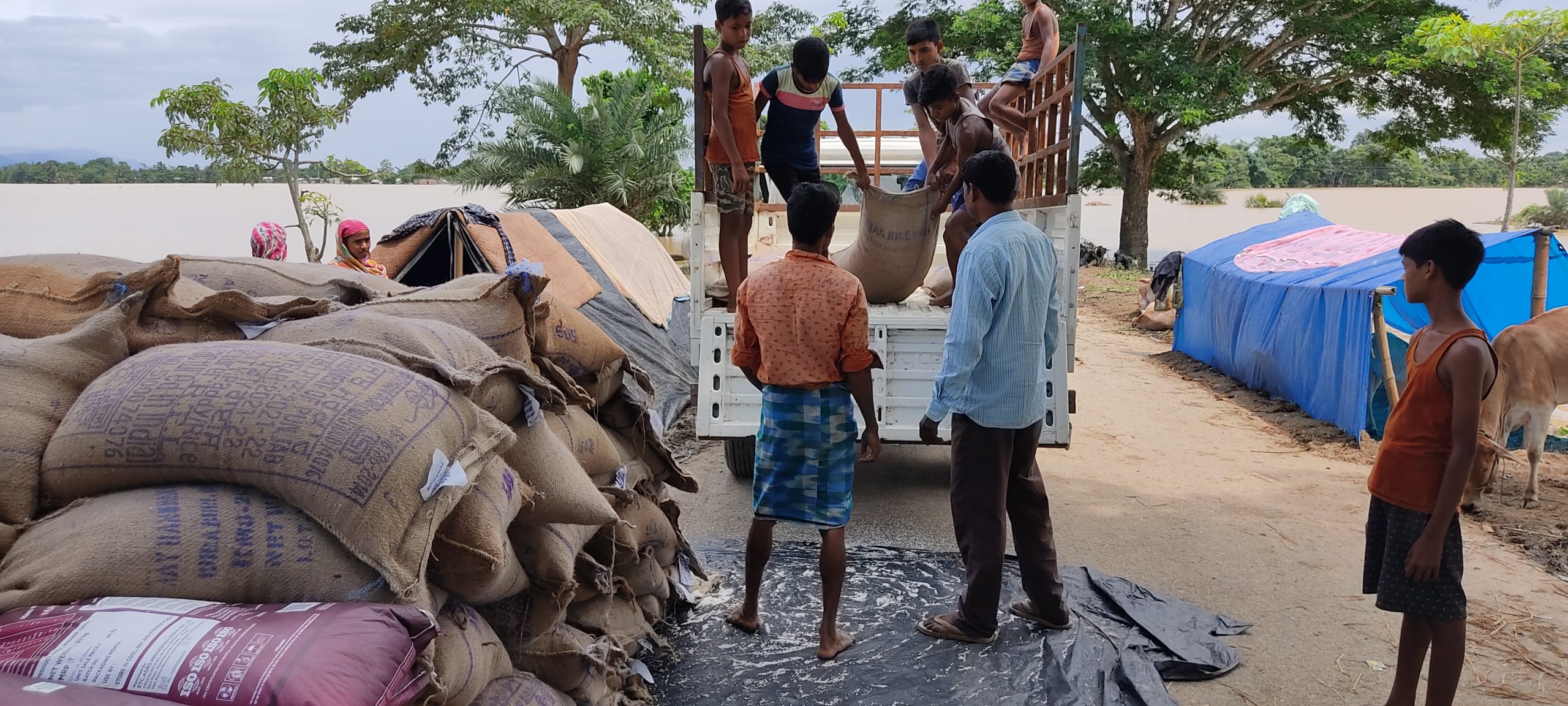- Assam faced two severe waves of flood this year, the first one in May and then again in June, which crippled cities and rural areas.
- Silchar, the second largest city of Assam faced its worst flood in living memory with more than 80% of the city being inundated.
- Assam received excess rainfall in the premonsoon season from March to May this year– 672.1 mm instead of an average of 414.6 mm, the highest in ten years. This is the primary cause behind the devastation, though human-caused disturbances have aggravated the situation.
On the edge of the National Highway 31 in Assam, where floodwater had completely submerged the paddy fields, 43-year-old Rahisuddin was waiting with his wife and five children. Rahisuddin, a resident of Kakoti Gaon, under the Raha subdivision of Nagaon district in the state was waiting for a boat to go back to his village and check on his house. His family, along with most other Kakoti Gaon residents, had left the village after the first wave of flood in May and was now living, with their cattle and whatever belongings they could bring with them, in makeshift camps made of tarpaulins.
He was bargaining with a boatman who was ferrying people at a fare of Rs. 20 per person. “Won’t give anything more than Rs. 10 per person,” Rahisuddin told the boatman. When asked why he was going back to his village now, he told Mongabay-India that he wanted to take a chance to see if the water has receded a bit. “We left the village after the first wave of flood in May and for the last one month, we have been moving from one place to the other. Like most people in my village, I work as a daily wager and catch fish sometimes, but now because of the flood, I don’t have any employment.”
“Initially, we took shelter at Chapormukh railway station as it was not flooded. Then we moved here to the highway for the last 15 days. It is very difficult living like this with my children. So if the situation in the village improves a bit, I will go back to my house,” Rahisuddin said.
When Rahisuddin managed to reach his mud house with a tin roof, he found the rooms flooded with water up to his chest. When Mongabay-India contacted him over the phone the next day, he said it was impossible to stay there. “We are staying near the railway track on the Chapormukh railway station. Hundreds of other families are also staying at the railway station now.”
Rahisuddin and his family are one of the millions who have been hit by this year’s flood in Assam. As per the latest flood bulletin released by the Assam State Disaster Management Authority (ASDMA), 31,54,556 people in 2,675 villages in 26 districts are currently affected. As many as 3,12,085 people are currently staying in 560 relief camps across the state. The death toll so far is 151.

Flood is an annual occurrence in Assam with Rashtriya Barh Ayog (National Flood Commission) calculating 39.58% of the total area of the state as flood-prone. The state also has 9.40% of the total flood-prone area of the country. Assam faced two severe waves of flood this year, the first one in May affecting parts like Barak Valley, NC Hills and Hojai and then again in June, which crippled most of Lower Assam along with Barak Valley. The pre-monsoon floods impacted rural districts like Barpeta, Nagaon, Morigaon, Nalbari, Kamrup (rural) etc. as well as urban areas such as Silchar, the second largest city of Assam, which had 80% of its area was inundated.
Assam received 62% above normal rainfall in the pre-monsoon season from March to May this year: 672.1 mm instead of an average of 414.6 mm, the highest in ten years. The excess rainfall is behind the devastation with human-caused disturbances aggravating the situation. Assam’s neighbour Meghalaya recorded 93% above normal rainfall in the same season.
Climate scientist Partha Jyoti Das said more data is needed to do event attribution (to climate change) but climate change, as per model projections, is likely to cause more frequent, heavy to extremely heavy, rain episodes in the northeast region. “Therefore, there is a high likelihood that we are already observing extreme rainfall events in our part of the world.”
Bhupen Goswami, former director of the Indian Institute of Tropical Meteorology (IITM) said climate change is definitely a factor contributing to the heightened impacts of the extreme event.

“Earlier, if extreme weather events were happening every 100 years, then now maybe they will happen every ten years. But floods in Assam are also a result of bad management of dams. The flood which is affecting Barpeta and other places of Lower Assam is because of water released from dams in Bhutan and the impact was aggravated by the heavy rain. The meteorological community gave a good forecast this year that there are going to be intense spells of rain. So, keeping that in mind, the release of water from dams should have been planned better,” Goswami told Mongabay-India.
Guwahati under water
Thirty-four-year-old Dhaneswar Das, who ran a paan (betel leaf) shop in the lanes of Rukmini Nagar in Guwahati was unable to open his shop for seven straight days as waist-high flood water had inundated most parts of his lane. Das devised a novel way to sell his stuff and keep his kitchen running during the extreme rainfall event. He built a raft with bamboo and kolgos (banana tree stems) and started selling items like packaged mineral water bottles, candles, match sticks and betel nuts. “Not just me, many other people had come up with such makeshift rafts in our lane. Some people were selling vegetables on these rafts while some people were using them to navigate through the flooded bylanes,” he said.
On June 13, heavy rainfall had hit the city and after a week of continuous rain, a large chunk of Guwahati was submerged. As boats were seen in areas like Rukmini Nagar and Hati Gaon, netizens started dubbing the city “Venice”. On June 19, when Mongabay-India visited Rukmini Nagar, most of the area had waist-deep or knee-deep water. Anup Deka, a resident of Rukmini Nagar said that earlier, the area saw flash floods but floodwater never remained in the locality for such a prolonged period. Deka, who is an auto van driver by profession, said, “I couldn’t take out my vehicle for seven days. The water reached my bed and I had to send my family away to a safer location.”

While flash floods are not new for the biggest city of northeast India, Guwahati, this year’s deluge exacted a heavy toll. The rainfall also caused severe landslides in many of the hills surrounding the city and in one tragic incident at Boragaon, four construction workers were buried in the debris of their makeshift accommodation. The incident happened on the night of June 13 and a family which was occupying the next room had a close shave. Shivam Sarkar, narrating that ordeal told Mongabay-India, “We heard a loud sound at night and came out and saw large chunks of mud crashing on our room. Next day, the Deputy Commissioner asked us to shift to another location and we have now taken up a rented house elsewhere.”
As landslides were reported in quite a few hills around Guwahati, many people whose homes were destroyed took shelter in the relief camps set up by the district administration.

Engineer J. N. Khatanair, also the technical advisor of Guwahati Metropolitan Development Authority (GMDA), said that unplanned city growth due to heavy human influx with uncontrolled construction activities are the main reason behind flood in Guwahati.
“The present flood experienced in Guwahati is human-caused. Massive unauthorised human habitation taking place in the hill area with deforestation haphazardly taking place has also played a major role in aggravating the flood situation in the city,” he said.
Silchar submerged
Silchar, the second most populous city of Assam after Guwahati, resembled a set from a disaster movie, with more than 80% of its area submerged since last week. Like Guwahati, Silchar residents are also not alien to flash floods triggered by heavy rainfall.
However, when the water level started increasing on June 21, nobody in Silchar had even imagined what was to follow. On June 22, almost the entire city was inundated. While the rainwater from neighbouring hilly states like Manipur and Mizoram added to the flooding, breaching the Bethukandi dyke on Barak river was primarily responsible for Silchar’s fate.
“My father suffers from hypertension and needs his blood pressure medicine daily. However, stock of one of his medicines finished, and it had to be procured anyhow. There is a pharmacy hardly 200-300 meters from our residence, but no pharmacy nearby was open that day. My brother had to wade through 5-6 km of chest-high flood water before finally finding a pharmacy and my father’s medicine,” recounts Nilotpal Bhattacharjee, whose family lives in Kanakpur, a severely affected locality in Silchar.
Thirty-four-year-old Bhattacharjee, an academic and journalist currently in Tezpur, is having sleepless nights worrying about his aged parents and younger brother back home. Silchar’s residents have questioned the government for the lack of timely intervention.

“Despite having information, the government didn’t repair that embankment,” said Krishanu Bhattacharjee, who is also the convenor of the Silchar Chapter of India March for Science. He further said it is the need of the hour to make wetlands near Silchar like Mahisha Beel and Malini Beel encroachment free. Cachar Cancer Centre, the premier cancer facility in Barak Valley, established in 1996, also faced a major problem when the campus and parts of the hospital building were waterlogged.
Speaking to Mongabay-India, Kalyan Chakraborty, founder and Chief Administrative Officer of the hospital, told Mongabay-India, “The entrance of the hospital is flooded, so we are transporting patients on makeshift rafts. Currently, 140 patients are admitted to the hospital along with 200 staff. We are grateful to the administration and civil society for helping us with supplies so that we could take care of all these people.”
H. P. S Kandari, Commandant of 1st Battalion of NDRF, told Mongabay-India that the magnitude of the flood combined with the city’s large population was scuttling disaster response efforts in Silchar. “We have 22 units in Assam, of which nine are in Silchar. In some areas, the current is too strong. Maintaining our equipment is sometimes difficult because we don’t know what is beneath when we ply our boat in these waters. So, sometimes our boats get punctured. We have mobile workshops to repair such damage though it is not always possible to send mobile workshops everywhere at such short notice. We are working without rest in this situation to ensure we can reach everyone needing help.”
No respite in rural Assam
On a portion of the road which connects Nagaon district’s Raha to Jakhalabandha, one can see a cluster of small tents that have now become the home of Podumoni and Kakati Gaon village residents. Hafizuddin, who came from Podumoni, has been living with his family of ten in a small tent for the last ten days that he had never seen such a devastating flood before. “This is bigger than 2004 (flood),” he said.
The village residents say their houses were submerged because water was released from three dams- Umrangshu, Karbi Longpi and Khendong. Not just the village residents, but many government officials have also been unable to return home after the floods.

Parishmita Saikia, Flood Officer at Raha Circle Office, has been living in her office for the last 15 days. “My house is 7-8 km from Raha. I have heard that water has also entered my house, but I have been unable to go to check on my parents. I have to stay till three at night because there is so much paperwork involving the relief work. There is a colleague’s house nearby where I go and freshen up sometimes,” said Saikia.
The NDRF is assigned the task of sending relief to some of the worst affected areas. Mongabay-India encountered one such team at Raha. Inspector Milan Jyoti Hazarika, who was leading the team, said that while he hails from Lakhimpur, known for its floods, the event he witnessed this year will be unmatched for its intensity. “In Chapormukh, we rescued people whose houses were completely submerged, and somehow they had taken shelter on the roof,” Hazarika said.
Sofiqul Islam, who conducts boat clinics at the chars or riverine islands of Barpeta district, said that in Lower Assam, the havoc was mainly created by the swollen tributaries of the Brahmaputra like Jiabharali and Pagladia. He also expressed concern over waterborne diseases affecting the flood victims once the floodwater recedes.
Criticising the government approach towards flood management in the region by constructing embankments, independent researcher Mirza Zulfiqur Rahman said, “Flood management in this region means constructing embankments which are nothing but merrymaking for contractors. Since the 1950 earthquake, we are constructing risks (embankments and dams) in the landscape without properly mapping the floodplains. Even small dams like Kopili, Ronganodi and Umrangshu can create huge havoc.”
“If you remove even one boulder from the river bed, it will have an impact. These boulders act as cushions, and the floodwater will come in much higher intensity in their absence. The interventions we are doing on the ground can lead to catastrophic events. Entire northeast India is sitting on a veritable pack of cards, ready to collapse. The way this government responds to climate change shows that they are not even keen to acknowledge this issue. They are piling double the infrastructure of what our landscape can absorb,” Rahman added.

The Assam State Disaster Management Authority (ASDMA) has plans like developing climate-resilient villages to combat floods. Elaborating on this, Mandira Buragohain, Project Officer (Knowledge Management and Climate Change), ASDMA said, “We are planning to come up with climate-resilient villages in Assam which will have a raised platform, handpump built on an elevated structure, community cowsheds and also we will do capacity building of women and youth. We will be setting up flood shelters in Bihpuria, Majuli and Barpeta where around 500 people can take shelter.”
When asked if the challenges are more this time, she said, “2020 was also very challenging because along with the flood, there was also a raging pandemic. However, this year the flood is more intense.”
Banner image: A shop set on a raft in Guwahati. Assam has 9.40 percent of the total flood-prone area of the country. Photo by Nabarun Guha.














